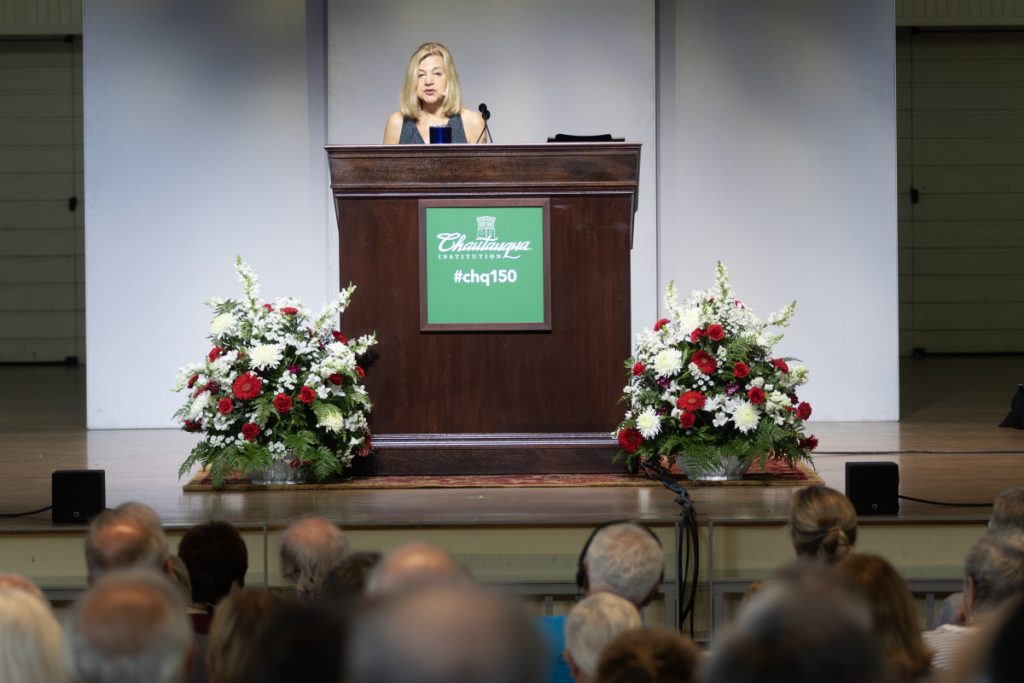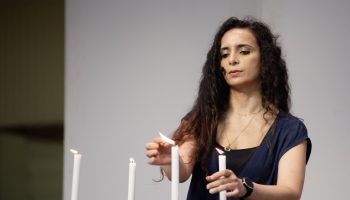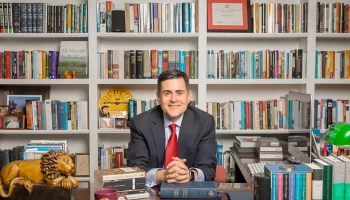
Margaret Sullivan, former editor in chief of The Buffalo News, and the executive director of the Craig Newmark Center for Journalism Ethics and Security at Columbia Journalism School, speaks on the importance of local journalism as a part of the Chautauqua Lecture Series on Tuesday in the Amphitheater.
Like any good reporter, Margaret Sullivan is clear, direct and transparent with her audience. The journalist laid out her lecture at 10:45 a.m. Tuesday in the Amphitheater in three concise sections: a problem, why it matters and, most importantly, a solution.
Sullivan, an award-winning media critic, weekly columnist for the United State publication of The Guardian, and executive director of the Craig Newmark Center for Journalism Ethics and Security at Columbia Journalism School, took the Amp stage to reflect on the decline, current state, and future of local and regional journalism, part of the Chautauqua Lecture Series theme “Our Greatest Challenges (That We Can Actually Do Something About).”
Sullivan began her lecture by recounting how watching the Watergate scandal unfold sparked her interest in a lifelong career in journalism. She recollected a conversation with her older brother about what she wanted to do with her life, and her realization during this talk that she wanted to pursue journalism.
She began as an intern at her hometown newspaper, The Buffalo News, and later worked her way up the chain of command to become the first female editor in chief of the newspaper. Later in her career, she served as media columnist for The Washington Post, and was the fifth (and first female) public editor at The New York Times.
When she started at The Buffalo News, the paper was wildly profitable because it was one of few ways advertisers could reach consumers.
Sullivan said Warren Buffett, who owned the newspaper, compared their profitability at the expense of advertisers to that of an unregulated toll bridge.
“He compared owning a paper in a monopoly market to owning an unregulated toll bridge,” she said. “You could charge what you wanted, in other words, because you had to get there, and so you would pay whatever it was.”
Soon, though, newspapers’ monopoly on advertising began to weaken. With the launch of Craigslist and other online platforms, smaller advertisers who might have taken to putting classified ads in a newspaper found themselves able to list ads on the internet for free. Later, Facebook, Google and other companies bolstered their advertising capacities and newspapers no longer had the upper hand they once did.
When the Great Recession hit, advertisers could not afford to purchase ads at the same pace and rate as they once could and, according to Sullivan, the newspaper industry has not made a full recovery since.
Local and regional newspapers, once boasting mastheads with hundreds of people, dwindled in size and scope as profits fell. She discussed watching her newspaper’s local competitor, The Courier Express, go under and experiencing firsthand the slow decline of local and regional papers.
This experience wasn’t limited to Sullivan and Western New York, however, but a widespread phenomenon all over the nation: the downfall of local news outlets. The issue was that newspapers were unable to adapt quickly to a changing world in which consumers were finding news — for free — on the internet, and she said the news industry itself was largely responsible for this.
“The newspaper business, in its lack of wisdom, decided to simply take our content, which was produced by these 200 people in a newsroom and the press men and all these people who had to be paid, and put it online for free,” she said. “Now, I kind of remember that that seemed to make sense at the time. But when we look back on it, maybe not so much.”
After outlining the factors that have led to the decline in local news outlets, Sullivan discussed the consequences.
She told a story of an investigative project spearheaded by a couple of reporters at The Buffalo News following a tragic plane crash in one of the city’s suburbs in 2009. National media moved to other news after covering the event for a few days, but local news continued to cover it for months, leading to the eventual investigation into the failures that led to the tragedy.
“What (the local reporters) found out over a number of months and a lot of looking at documents and a lot of digging and all the things that investigative reporters do, is that this crash happened at least in part because of pilot error, and the pilot error was caused, in part, by the lack of regulation about how much sleep, for example, a pilot had to get, how much training a pilot had to get,” she said.
This investigative reporting, combined with the advocacy of the families of the victims of the plane crash, led to significant safety reforms and legislation ensuring that similar tragedies wouldn’t happen again. She said the journalism produced by the reporters has saved lives by, in part, leading to the regulations put in place.
“But here’s the thing,” she said, “it’s hard to do that work now. It’s very hard to take two reporters on a small staff and spin them off for a couple of months and say ‘Go do this investigative work.’ So, one of the things that we lose when we lose local journalism is this investigative work that really makes a difference in our communities and, in fact, in our world.”
To Sullivan, the impact of the decline of local news is immeasurable. Without local news, national outlets — without the same attention to specific communities or ability to engage in hyper-localized investigative reporting — will be the only news (print or otherwise) for many people to engage with.
When local news is diminished, Sullivan said, people tend to demonstrate more political polarization aligned with the nation’s two major political parties, and fewer people vote across party lines.
She emphasized the media’s role as a government watchdog that holds elected officials accountable to the public. When the fourth estate is unable to observe and record the activities of the government adequately, the government is more susceptible to corruption.
She said the presence of local journalism imbues an important sense of community, grounded in truth and reality.
“I think one of the things that worries me the most is that when local journalism dries up, we lose a common basis of truth and reality,” Sullivan said. “You could disagree with your neighbor about issues or about politicians or about what was happening, but you kind of shared the fact that things were based on some facts. I think we’ve really, really lost that.”
She specifically acknowledged the loss of cultural criticism written by local journalists — it’s a loss to communities’ vibrant, localized cultures to outsource things like book reviews and other forms of culture journalism to national outlets and wire services.
“When you have a newspaper that’s paying attention to that culture, it makes a huge difference,” she said. “… That is just one example of many things that help tie the community together — (journalism that is) not about corrupt government, but about the culture of the community.”
The news media, however, can move forward sustainably, Sullivan said. As an example, as the newspaper industry was in the midst of a major loss of advertising revenue in the early 2000s, there were a few philanthropists who decided to contribute their wealth to form a new news organization: the now wildly-successful longform investigative outlet ProPublica. She also highlighted the many emerging non-profit digital news organizations that focus on regional investigative work at a smaller, more localized scale. The obstacle with these organizations, according to Sullivan, is that they can be difficult to scale.
While Sullivan feels positively toward the emerging non-profit model in local news, she worries that it will take hold in major cities and leave rural areas — where good journalism is most desperately needed — behind.
“You can have a couple hundred of (non-profit outlets), but you can’t have one everywhere,” Sullivan said. “And, unfortunately, you tend not to have them in the places that are least well-served by local news. They tend to come up in places that are already metropolitan — probably have a newspaper, probably have television stations. They are not generally in rural areas; they are not generally in news deserts.”
Non-profit news models are an “important bright spot” and it is important to support them, she said, but they are not really the answer — in fact, the truth is that there is no single answer.
Sullivan also pointed to government assistance that aims to help support local news. There’s hesitation on the part of news outlets to accept this assistance, of course, because of the need to maintain editorial independence, avoid conflicts of interest, and ensure uncompromised watchdog reporting, but Sullivan believes that currently, this aid toes that line appropriately.
Sullivan pointed to Report for America, an organization similar to the Peace Corps that sends early-career journalists across the country to cover under-reported issues in the nation. She also acknowledged the Rebuild Local News Coalition, which is advocating for legislation that would help rebuild local news across the country.
Sullivan asked her Chautauqua audience to understand that quality, in-depth news comes at a cost and, therefore, consumers should expect to pay for their news.
As a call to action, she proposed multiple ways that audience members could support local journalism.
“You can care about local news. You can talk about local news. You can follow it,” Sullivan said. “You can debate it. You can know what’s going on in your communities, and I’m guessing that you mostly do, but a lot of people don’t, so that’s the first part: to care about it and to engage in your communities.”
She continued: “You can continue to pay for local news. You can subscribe. You can contribute. You can read more than one source of local news. You can compare and contrast. You can also communicate with the editors and the reporters at these local news organizations. … I think it’s important to let people know what you’re thinking.
“You can support efforts to save local news. … I think it’s extremely important: You can be an engaged citizen at the local level. You can make sure that you vote, you can make sure that your neighbors and friends vote, you can get some of your family members who aren’t registered to vote to be registered and to vote.”
In closing, Sullivan said that while she is not optimistic about the future of local journalism, she is hopeful.
“If everyone in America — or even if everyone who still believes in a reality-based press — were to pitch in, I think we can restore the foundations of local journalism and then begin to rebuild in earnest,” she said. “It could not be more important that we do just that.”




